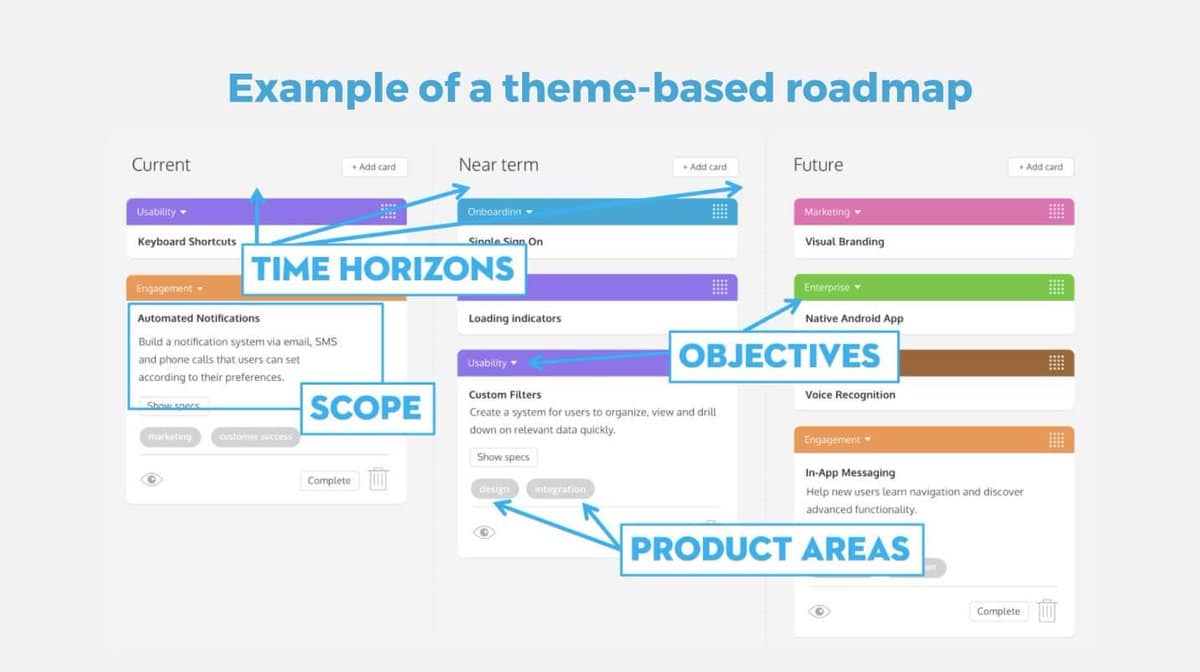
Product managers are an integral part of the brains behind great innovations. They coordinate cross-department teams, communicate high-level product strategy with stakeholders, and create solutions to challenges. They are leaders, architects, and visionaries. Product managers need to be highly organized, detail-oriented, and agile to get the job done.
Whenever you need an advanced reporting and exporting platform that will boost Trello’s capabilities, consider Bridge24 for Trello.
This flexible project management application can be introduced at any phase of the product lifecycle. Its layout makes it a perfect place to create detailed product roadmaps. With Trello, project managers can visualize a product’s short and long-term direction, manage requests, communicate ideas, and prioritize backlogs. Project managers can combine Trello with other tools depending on the task at hand to gain more control over product-related projects.
What is a Product Roadmap?
You’ve devised a great product idea, set goals and targets, and communicated it to your team. But how do you turn a promising vision into a successful product? What route do you use to accomplish your objectives? Enter: the product roadmap.
Whether you are a large company developing several products or a small business focusing on a single creation, a product roadmap is a must-have item. In simple words, a roadmap is the shared blueprint for your vision. It contains the steps and goals needed to achieve your ambitions. This roadmap can be kept private or shared with the public for transparency and to encourage end-users to share suggestions.
Setting Up a Trello Board for Your Product Roadmap
Step 1: Create a Board
Log in to your Trello account, navigate to ‘+’ in the header, and click the ‘Create Board’ option. You can name your board ‘Product Roadmap.’ This Board is where your lists and cards will be housed. Boards are like file folders as they store all information regarding a project. After creating it, you can invite your team to it, and they can edit and update its contents.
Step 2: Create and Organize Lists
A Trello board includes ‘To Do,’ ‘Doing,’ and ‘Done’ lists in its most basic form. Lists are like sub-folders, and they appear on the board horizontally. They divide the board into sections and can be used to represent subprojects, stages of the work, timelines, and much more. Since a product roadmap is quite complex, you need to break down the roadmap into phases using lists.
You can have lists representing a status in the feature development lifecycle. E.g. ‘Ideas’, ‘Research and Design’ Future’, and ‘Done’, or divide the roadmap into timeframes, for example, ‘About this Roadmap’, ‘Near-Term’, ‘Medium-Term’, and ‘Long-Term’.
Step 3. Add Cards to Your Roadmap
After creating lists, you need to place cards inside them. Cards appear vertically one beneath another, representing tasks, checklists, documents, instructions, steps in the process, due dates, and much more. They can be moved from one list to another to indicate a change in the status of a given task.
If you split your roadmap into timeframes, use the following process. In the ‘About this Roadmap’ list, you can add cards like ‘Disclaimer,’ ‘Contact Information,’ ‘How the Board Works,’ and other general information in the ‘How the Board Works’ card, explain the meaning of each status.
When adding cards, collaborate with team members and stakeholders to create cards relevant to your short, medium, and long-term objectives. Remember that you can further break down cards into checklists of to-do things.
Tips for Creating a Product Roadmap
1. Prioritize Work – With so many things to be done, it’s hard to determine what tasks should take precedence over others. To ensure you are making strategically sound decisions, and prioritizing the right things, introduce a rating system to Trello. To do this, combine Trello with the air focus integration. This Power-Up has a great scoring system that will help determine which tasks to focus on first.
2. Collect Feedback – To collect feedback concerning your product, consider making your roadmap public and enable comments and votes. The users’ input can give you insight into areas you are doing well and help you learn some pressing customer demands.
3. Label Items – To make your roadmap more readable and easy to navigate, use labels to color mark cards. Labeling will help you track items on your board faster by filtering. You can also have a card in the first list explaining the color tags used on the board.
4. Keep the Board Simple – You could easily get overwhelmed if you put too much information on your Trello roadmap. Too many details will make it difficult to find what you want. Therefore, keep the number of lists small.
Conclusion
Trello is a powerful and versatile tool that product managers can use to create and manage a product roadmap. At a glance, project managers can see what’s being worked on by which team or members, what’s pending, and what’s done. It’s simple, and you can use it to pursue your business’s strategic goals. If you want to enhance Trello’s reporting and chart capabilities to gain better insights from your tool, combine it with Bridge24 for Trello.
External sources: What is a Product Roadmap, The Ultimate Guide to Product Roadmaps, What is a product roadmap?
Daniel Raymond, a project manager with over 20 years of experience, is the former CEO of a successful software company called Websystems. With a strong background in managing complex projects, he applied his expertise to develop AceProject.com and Bridge24.com, innovative project management tools designed to streamline processes and improve productivity. Throughout his career, Daniel has consistently demonstrated a commitment to excellence and a passion for empowering teams to achieve their goals.